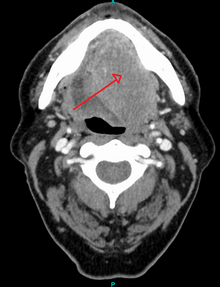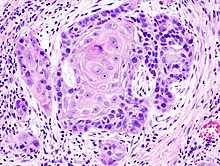Squamous cell carcinoma
Squamous cell carcinomas (SCCs), also known as epidermoid carcinomas, comprise a number of different types of cancer that result from squamous cells. These cells form the surface of the skin and lining of hollow organs in the body and line the respiratory and digestive tracts.
Common types include:
- Squamous cell skin cancer: A type of skin cancer
- Squamous-cell carcinoma of the lung: A type of lung cancer
- Squamous cell thyroid carcinoma: A type of thyroid cancer
- Esophageal squamous cell carcinoma: A type of esophageal cancer
- Squamous-cell carcinoma of the vagina: A type of vaginal cancer
Despite sharing the name “squamous cell carcinoma”, the SCCs of different body sites can show differences in their presented symptoms, natural history, prognosis, and response to treatment.
Types
Head and neck cancer
About 90%t of cases of head and neck cancer (cancer of the mouth, nasal cavity, nasopharynx, throat and associated structures) are due to SCC.
Thyroid[
Primary squamous cell thyroid carcinoma shows an aggressive biological phenotype resulting in poor prognosis for patients.
Esophagus
Esophageal cancer may be due to either esophageal squamous cell carcinoma (ESCC) or adenocarcinoma (EAC). SCCs tend to occur closer to the mouth, while adenocarcinomas occur closer to the stomach. Dysphagia (difficulty swallowing, solids worse than liquids) and painful swallowing are common initial symptoms. If the disease is localized, surgical removal of the affected esophagus may offer the possibility of a cure. If the disease has spread, chemotherapy and radiotherapy are commonly used.
Lung
When associated with the lung, it is typically a centrally located large-cell cancer (nonsmall-cell lung cancer). It often has a paraneoplastic syndrome causing ectopic production of parathyroid hormone-related protein, resulting in hypercalcemia, but paraneoplastic syndrome is more commonly associated with small-cell lung cancer. It is primarily due to smoking.
Penis
Human papillomavirus (HPV), primarily HPV 16 and 18, are strongly implicated in the development of SCC of the penis. Three carcinomas in situ are associated with SCCs of the penis:
- Bowen’s disease presents as leukoplakia on the shaft. Around a third of cases progress to SCC.
- Erythroplasia of Queyrat, a variation of Bowen’s disease, presents as erythroplakia on the glans.
- Bowenoid papulosis, which histologically resembles Bowen disease, presents as reddish papules.
Prostate
When associated with the prostate, squamous cell carcinoma is very aggressive in nature. It is difficult to detect as no increase in prostate-specific antigen levels is seen, meaning that the cancer is often diagnosed at an advanced stage.
Vagina and cervix
Vaginal SCC spreads slowly and usually stays near the vagina, but may spread to the lungs and liver. This is the most common type of vaginal cancer.
Bladder
Most bladder cancer is transitional cell, but bladder cancer associated with schistosomiasis is often SCC.
Diagnosis
Classification
Cancer can be considered a very large and exceptionally heterogeneous family of malignant diseases, with squamous cell carcinomas comprising one of the largest subsets. All SCC lesions are thought to begin via the repeated, uncontrolled division of cancer stem cells of epithelial lineage or characteristics. SCCs arise from squamous cells, which are flat cells that line many areas of the body. Accumulation of these cancer cells causes a microscopic focus of abnormal cells that are, at least initially, locally confined within the specific tissue in which the progenitor cell resided. This condition is called squamous cell carcinoma in situ, and it is diagnosed when the tumor has not yet penetrated the basement membrane or other delimiting structure to invade adjacent tissues. Once the lesion has grown and progressed to the point where it has breached, penetrated, and infiltrated adjacent structures, it is referred to as “invasive” squamous cell carcinoma. Once a carcinoma becomes invasive, it is able to spread to other organs and cause the formation of a metastasis, or “secondary tumor”.
Morphology
- Bowen’s disease is a sunlight-induced skin disease, and is considered to be an early form of SCC.
- Erythroplasia of Queyrat
- Keratoacanthoma is a low-grade malignancy of the skin. It originates in the pilosebaceous glands, and is similar in clinical presentation and microscopic analysis to SCC, except that it contains a central keratin plug. Statistically, it is less likely to become invasive than SCC.
- Marjolin’s ulcer is a type of SCC that arises from a nonhealing ulcer or burn wound. More recent evidence, however, suggests that genetic differences exist between SCC and Marjolin’s ulcer, which were previously underappreciated.
Microscopic appearance
One method of classifying squamous cell carcinomas is by their appearance under microscope. Subtypes may include:
- Adenoid squamous cell carcinoma (also known as pseudoglandular squamous cell carcinoma) is characterized by a tubular microscopic pattern and keratinocyte acantholysis.
- Basaloid squamous cell carcinoma is characterized by a predilection for the tongue base.
- Clear-cell squamous cell carcinoma (also known as clear-cell carcinoma of the skin) is characterized by keratinocytes that appear clear as a result of hydropic swelling.
- Signet ring-cell squamous cell carcinoma (occasionally rendered as signet ring-cell squamous cell carcinoma) is a histological variant characterized by concentric rings composed of keratin and large vacuoles corresponding to markedly dilated endoplasmic reticulum. These vacuoles grow to such an extent that they radically displace the cell nucleus toward the cell membrane, giving the cell a distinctive superficial resemblance to a “signet ring” when viewed under a microscope.
- Spindle-cell squamous cell carcinoma (also known as spindle-cell carcinoma) is a subtype characterized by spindle-shaped atypical cells.
SCC is a histologically distinct form of cancer. It arises from the uncontrolled multiplication of cells of epithelium, or cells showing particular cytological or tissue architectural characteristics of squamous cell differentiation, such as the presence of keratin, tonofilament bundles, or desmosomes, structures involved in cell-to-cell adhesion.
Prevention
Studies have found evidences for an association between diet and skin cancers, including SCC. The consumption of high-fat dairy foods increases SCC tumor risk in people with previous skin cancer. Green leafy vegetables may help prevent development of subsequent SCC and multiple studies found that raw vegetables, citrus fruits and noncitrus fruits are significantly protective against SSC risk. On the other hand, consumption of whole milk, yogurt, and cheese may increase SCC risk in susceptible people. In addition, meat and fat dietary pattern can increase the risk of SCC in people without a history of SCC, but the association is again more prominent in people with a history of skin cancer. Tobacco smoking and a dietary pattern characterized by high beer and liquor intake also increase the risk of SCC significantly.
Reference:
https://en.wikipedia.org/wiki/Squamous_cell_carcinoma
[kkstarratings]








